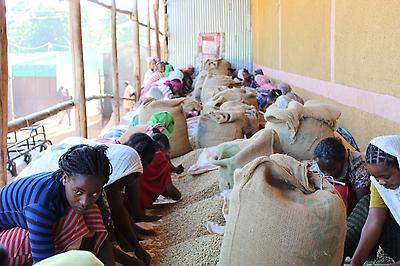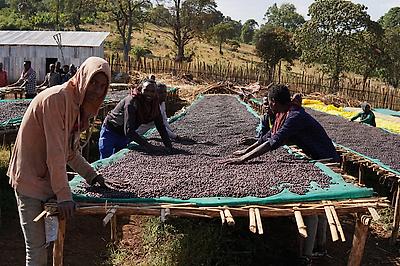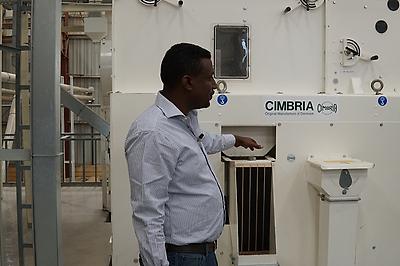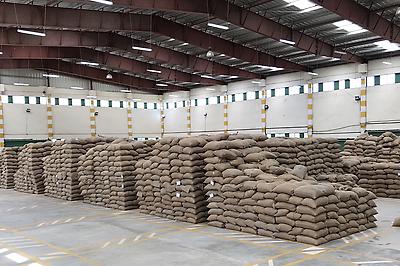Origin Report: Ethiopia 2019
I started off this year with a trip to Ethiopia to get a first-hand look at some of the places that our coffees have been grown and processed. Our friends at Nordic Approach were leading a tour of the Guji area for a group of excellent roasters from around the world, and I thought it would be a great way to meet our producers and farmers and learn some more details about the excellent coffees we’ve been seeing out of the region. What follows is a travel journal of sorts, documenting what I saw and learned about Ethiopia and the coffees that we’ve come to know and love.
Day 1
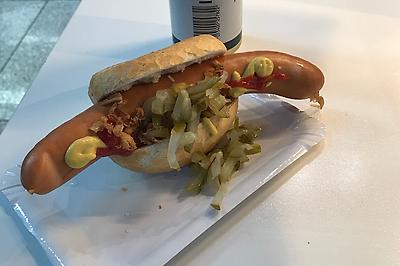
Who knew they had such great bockwurst in Ethiopia?! Just kidding - my flight was delayed due to some patchy weather in the Midwest, so I ended up spending almost a full day in a Frankfurt turning my 28 hour flight into a 52 hour flight (thanks Air Canada). Didn’t get the chance to do much coffee shop exploring, because I was spending the time figuring out how I was going to catch up with the rest of the group that was leaving Addis for Sidama on Tuesday Morning.
Day 2
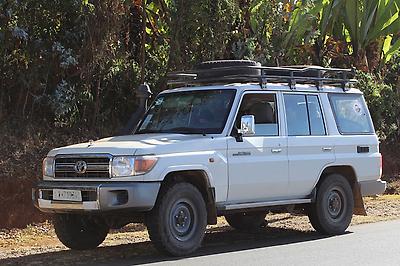
When I landed in Addis Ababa after the Frankfurt detour, I was an entire day behind the rest of the group. Thankfully, Israel Degfa offered to give me a ride down to Guji to rendezvous with the Nordic Approach crew. Severe petrol shortages in Ethiopia meant we couldn’t find enough gas to leave all day, but we eventually sourced a diesel vehicle that we could fuel up.
If the name sounds familiar, it’s because Israel owns several coffee mills in Ethiopia that have produced some of the great coffees we’ve shipped - you probably saw his name of a few bags of Moustache coffee. Israel is one of the leaders in specialty coffee quality in Ethiopia, and we had some great chats on the way down about his different projects. We met the rest of the group at Hawasa, a lake town in Southern Ethiopi and spent the evening there getting to know the folks from Nordic Approach (including the founder, Morten) and a bunch of cool roasters from all over the world.
Day 3
Things really got moving on the coffee front with our visit to Israel’s Anasora washing station. This is mainly a private washing station for Israel’s coffee, with coffee plants growing on the surrounding farms as high as 2300m. The station produces washed and natural coffees from local heirloom varietals, and is currently constructing a new washing facility to expand further production. Lots of attention goes into quality control at Anasora, a lot of which is done by hand: people sorting cherry before washing, and people sorting both washed and natural coffees during drying to catch any defects.
Anasora has been in operation since 2010, and in that time has also begun work to support the local community. Small-holders can sell their coffee cherry to be processed at the station, and Anasora provides husbandry (that’s livestock y’all) and financial assistance to local farmers looking to increase their yield. The washing station also provides financial support to the local orphanage and runs a program with the local school to build more school rooms and to teach kids about modern coffee farming.
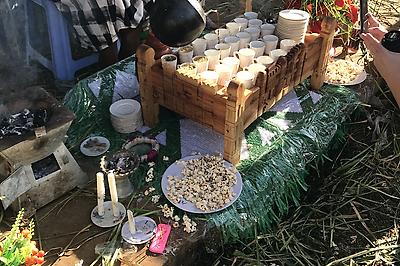
It was great to see a facility that’s so supportive of the local community, and you could tell from being there how happy everyone was to be sharing their coffee with the world. The community there extended great hospitality to us including food and dancing and a coffee ceremony with their elders. At the end of the day, we actually camped at the washing station, which really made us feel like we were welcomed into the community.
Day 4
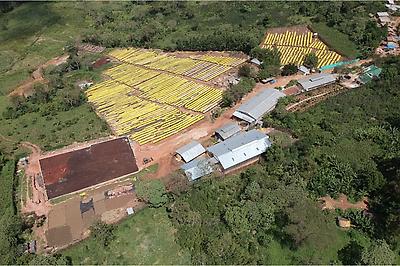
We woke up in our tents next to the washing station and packed up for a visit to another washing station - Adola. This washing station is located near one of Ethiopia’s most important gold mines, which is where it gets its name. It’s an impressive operation with over 300 drying beds and rigorous sorting standards for the local small-holder cherry. This aerial view gives a pretty good sense of the scale of this operation - they are serious about producing great coffee at Adola!
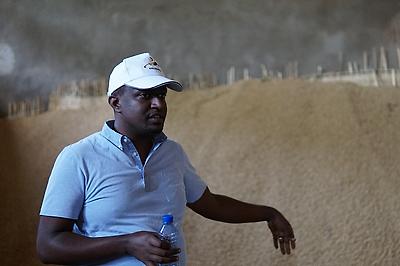
This is where we met Semeon Abay - who is one of Nordic Approach’s on-the-ground representatives in Ethiopia. He’s in charge of all the special projects and preparation experiments they’re running on different beans - things like reducing the amount of coffee drying on natural beds, which reduces fermentation and leads to a cleaner cup. At a washing station the size of Adola, there’s plenty of space to try new things and it’s great to see a bunch of new processes in the works.
Of course, Adola is also a fully functioning washing station which means we got to see plenty of coffee being prepared. They utilize an Agarde disc pulper to depulp the cherry - which also sorts the cherry by density at the same time to help grade the coffees once more before they go to drying. We spent pretty much the whole day in the Adola area, which wasn’t hard considering how big this washing station is and how much activity there was with all the different coffees being prepared.
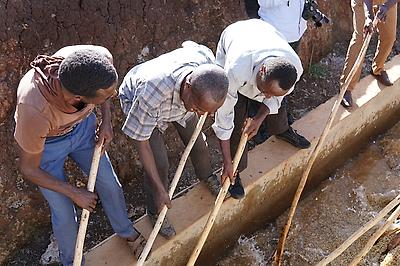
These channels are where coffees are floated to help remove any density defects. Pushing the coffee with rakes along the channel agitates the beans which cause defects to separate.
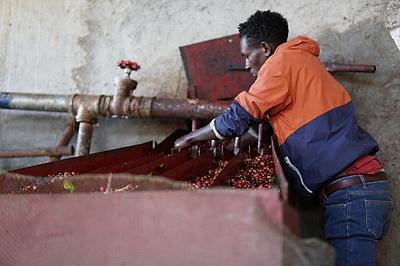
This disc pulper sorts the incoming cherries by density into different channels before pulping the cherry - removing the skin and some of the mucilage.
Day 5
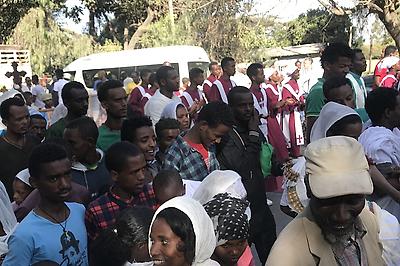
This was another travel day as the group left Guji, heading back to Addis Ababa to learn more about the dry milling and prep process that Ethiopian coffee undergoes before it gets loaded into containers and shipped our way. However, the drive took up most of the day, due to the celebration of Timkut. Ethiopia’s primary religion is Orthodox Christianity, and Timkut is their celebration of the Epiphany. It involves a lot of ceremonial baptisms, as well as parading replicas of the Ark of the Covenant through the street in celebration. Many of the roads we were driving filled with people celebrating the occasion, so we spent most of the day observing the festivities on our drive back to Addis Ababa. Things were genuinely off the charts, people were having fun and we weren’t moving - this is a Christmas-style holiday in Ethiopia with basically everyone taking part in the celebration.
Day 6
Back in Addis, we visited a dry mill - which is where the coffee is milled and prepared for shipping. Most processing facilities in Ethiopia (like the washing stations we visited) process coffee down to parchment and send it to Addis for milling and packing. Green coffee retains its quality much better in parchment, so this is a great way to keep the coffee flavorful and in good condition right up until it needs to be shipped. It also provides another touchpoint for quality control: coffees at the dry mill are measured and sorted by visual sorting machines after they are milled, removing any defects that managed to make it past all the sorting and floating at the washing stations.
Final Thoughts
One of the things that stood out most in Ethiopia is just how much manual labor goes into making sure the coffees are exceptional quality. So much of the coffee is sorted visually, floated and density-checked by hand, and spread out to dry by hand. The producers rely on machines where necessary, but compared to other origins the coffee itself is much more directly connected to the people who prepare it and they take a lot of pride in making it the best it can be.The same goes for the larger structures of coffee production in the region - there are just so many people involved. Compared to an origin like Colombia where a single farmer grows a crop, harvests it, processes it on-site at a beneficio and sells parchment to an exporter - coffee in Ethiopia is much more community-based. Most farmers are small-holders that grow heirloom varieties that have been on their land for generations. They bring their coffee together at a local washing station, where coffees from their area are processed and sorted before heading to Addis for milling. That’s why it’s not surprising to see the washing stations investing in their communities. The coffee they supply to Addis, and by extension to us, is a shared effort by many.
